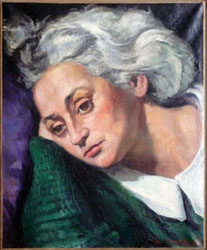
1939 : Enlisted on August 26th he fights in the "drôle de guerre" in the 101st infantry regiment, where he produces some drawings too. 
1940 : The 10 May, his regiment faces the German army at Chateau-Thierry.
Then it's the debacle. He is made prisoner in the Loire and is moved to the Melun camp on June 18th (1940). Sent to carry out manual labour in Saint-Saulieu in the Somme, he escapes in late August. He returns to Paris and makes himself available to the Communist Party and the Resistance.
He re-establishes contact with Jean Lurçat and Marcel Gromaire who return to Aubusson. Under an employment and home certificate issued by Lurcat, he assists him in the creation of cardboard tapestries.
Following threats by the police of Vichy, they split up for safety reasons. In fact, until this moment, he assisted in the making and distribution of clandestine papers headed by Bourdeau, which were active in the five departments of the Center of France
He then contacted the painter Menot in Cregols near Saint-Cirq-Lapopie (Lot).
In July he meets Aragon in Cahors.
He joins together with Menot, two autonomous clandestine groups for the "National Front for the fight for Liberty and Independence of France", an organisation of resistance created by the Communist Party.
He lives for a month by Raoul Dufy and then liaises with Marcel Weil in Montpellier.
13th November 1941: Boris was arrested in Cregols on a commission of the Creuse, and then brought before the session of the 13th region and sentenced to two years of imprisonment...
16th July 1942 : His mother is arrested during the Vel' d'Hiv' Roundup in Paris.
She is then sent to Drancy and finally transferred to Auschwitz, where she is murdered by the Nazis.
23rd July 1943: He is transferred to the military prison of Mauzac in Dordogne and registered under number 4186.
11th November 1943 : Although he has finished his sentence, he is transferred to the camp of Saint Sulpice-la-Pointe (Tarn)
He decorates the walls of the camp's shacks with frescos realised from the water paint that was utilised for the maintenance of substructures.
Cf."The Saint-Sulpice's frescos"
He also produces drawings.
31st July 1944 : The SS troops invade the camp and prisoners are deported to Buchenwald.
The journey take place in cattle wagons with sealed doors.
5th August 1944 : Boris Taslitzky arrives in Buchenwald. He will be referred to as number 69022 for 9 months.
11th April 1945 : He takes part in the camp insurrection and in its liberation.
A few days later he hands over his drawings to
Christian Pineau,
who was released earlier and asks him to deliver them to
Aragon.
2nd May 1945 : Repatriated, he arrives in Paris.
